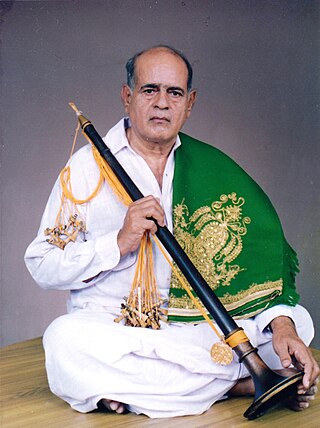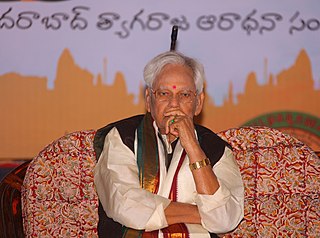See also
- Mashak, a Northern Indian bagpipe
- Sruti upanga, a bagpipe of Tamil Nadu.
The titti (Telugu : titti, [1] masaka titti, or tutti) is a type of bagpipe played in Andhra Pradesh, India, made from an entire goat-skin. [2] The instrument is described as a goatskin with a double-reed inserted into one leg, and a bamboo blowpipe into the other. [3] The term tittii is used in Telugu, Kannada, and Malayalam. [4]
Several paintings possibly depicting bagpipes are shown in Kerala, from the early eighteenth century. [5]
Colonel James Tod (1782–1835 CE) notes that the Yanadis, a forest tribe in Madras, also play the bagpipes, [6] [7]
The instrument is often used to provide solely a constant drone. References note the instrument being used as a drone accompaniment by storytellers and singers, [8] [9] as well as for village dance-dramas. [10]

Uppalapu Srinivas was an Indian mandolin player in Carnatic classical music and composer. Because he was a child prodigy, he was sometimes called the Mozart of classical Indian music.

Indian classical dance or Shastriya Nritya is an umbrella term for various performance arts rooted in Hindu musical theatre styles, whose theory and practice can be traced to the Sanskrit text Natya Shastra. The number of classical dances range from eight to more, depending on the source and scholar. The Sangeet Natak Academy recognizes eight – Bharatanatyam, Kathak, Kuchipudi, Odissi, Kathakali, Sattriya, Manipuri and Mohiniyattam. Scholars such as Drid Williams add Chhau, Yakshagana and Bhagavata Mela to the list. Additionally, the Indian Ministry of Culture includes Chhau in its classical list. These dances are traditionally regional. They consist of compositions in Hindi, Malayalam, Meitei (Manipuri), Sanskrit, Tamil, Odia, Telugu, or any other Indian language and they represent a unity of core ideas in a diversity of styles, costumes and expression. Currently, there are 9 official classical dances in India.

Sangeet Natak Akademi is the national level academy for performing arts set up by the Government of India.

Sheik Chinna Moulana, popularly known as Sheik, was a legendary nadhaswaram player in the Carnatic tradition. He was awarded the Madras Music Academy's Sangeetha Kalanidhi in 1998. He achieved high position through his outstanding control over the instrument, rendering the Krities in the Gayaki style and for his extraordinary style of Raga Alapana.

Telugu theatre is Indian theatre in the Telugu language, based in the states of Andhra Pradesh and Telangana. Gurajada Apparao wrote the play, Kanyasulkam in 1892, which is often considered the greatest play in the Telugu language. C. Pullaiah is cited as the father of Telugu theatre movement.
Pakala Venkataramana Rao Rajamannar (1901–1979) was an Indian judge and politician who served as the acting Governor of Madras State from 1957 to 1958. P.V. Rajamannar was the first Indian to become Chief Justice of Madras High Court after independence from 1948 to 1961. He was also the first Chairman of Sangeet Natak Akademi in New Delhi.

Echampati Gayathri, popularly known as "Veena Gayathri"(born 9 November 1959) is a veena exponent of the traditional Carnatic music. She was appointed by the Chief Minister of Tamil Nadu, J.Jayalalithaa, as the first Vice Chancellor of Tamil Nadu Music and Fine Arts University in November, 2013.
Banda Kanakalingeswara Rao was an Indian actor known for his works in Telugu theatre, and Telugu cinema. He was the member of Kendriya Sangeet Natak Akademi since 1952 and Andhra Pradesh Sangeet Natak Akademi since 1957.
Nataraja Ramakrishna was an Indian dance guru. He was the chairman of Andhra Pradesh Sangeeta Nataka Academy. He was also a scholar and musicologist who promoted classical dance in Andhra Pradesh and worldwide.

K. Uma Rama Rao was an Indian Kuchipudi dancer, choreographer, research scholar, author and dance teacher. She was also the Founder & Director of Lasya Priya Dance Academy, established in 1985 in Hyderabad, India.

Balantrapu Rajanikanta Rao was an Indian writer, composer and poet in the Telugu language. He was the son of Balantrapu Venkatarao, one of modern Telugu poet-duo "Kavi Rajahamsa" Venkata Parvateswara Kavulu. He won several national and state level awards for his work. He died in April 2018 at the age of 98.
The mashak is a type of bagpipe found in Northern India, Uttarakhand, Sudurpaschim Province of Nepal and parts of Pakistan and Afghanistan. The pipe was associated with weddings and festive occasions. In India it is historically found in Garhwal (kumaon) in Uttarakhand, Rajasthan and Uttar Pradesh. This bagpipe uses single reeds, and can be played either as a drone or as a melody instrument.

The sruti upanga is a type of bagpipe played in Tamil Nadu, southern India. The instrument was often used to supply a drone to accompany mukha vina music.

Karaikudi Sambasiva Iyer was noted Indian classical musician and Veena player.
Shanta Rao was a notable dancer from India. She studied and performed Kathakali, Bharatanatyam and Kuchipudi.

Pichu Sambamoorthi (1901–1973) was an Indian musicologist, writer and the professor of musicology at the Sri Venkateswara University, Tirupati. He was the author several books on music, including A Dictionary of South Indian Music and Musicians, Great composers, South Indian Music, Sruthi Vadyas (Drones) and Laya Vadyas: Time-Keeping Instruments. He was awarded the Madras Music Academy's Sangeetha Kalanidhi in 1972. The Government of India awarded him the third highest civilian honour of the Padma Bhushan, in 1971, for his contributions to music. He was also a 1963 recipient of the Sangeet Natak Akademi Fellowship.
Vedantam Satyanarayana Sarma (1935–2012), popularly known as Satyam, was an Indian classical dancer and choreographer, considered by many as one of the leading exponents of the classical dance form of Kuchipudi. He was known for his portrayal of female characters such as Usha, Satyabhama, Deva Devi, Mohini, Sasirekha and Gollabhama (Gollakalapam). He was a recipient of several honors including Kalidas Samman, Sangeet Natak Akademi Award and Sangeet Natak Akademi Fellowship. The Government of India awarded him the fourth highest civilian honour of the Padma Shri, in 1970, for his contributions to Dance.

Annavarapu Rama Swamy is an Indian classical violinist from Andhra Pradesh, India.
Nidumolu Sumathi, also known as Dandamudi Sumathi is an Indian percussionist, primarily playing the mridangam. She is married to "Mridangam Maestro" Sri Dandamudi Ram Mohan Rao. She is one of the first female mridangam players in India, and the first female Laya Vinyasam artist. Sumathi received India's fourth-highest civilian award, Padma Shri, in 2021.

Gaddam Padmaja Reddy is an Indian Kuchipudi exponent and music teacher. She performs ballets on mythological themes and contemporary social issues. She choreographed Kakatiyam, a Kuchipudi visual dance form. She was conferred with Kala Ratna in 2006, India's highest art award–Sangeet Natak Akademi Award in 2015 and Padma Shri, India's fourth highest civilian award, in the field of art for 2022.